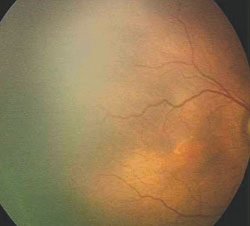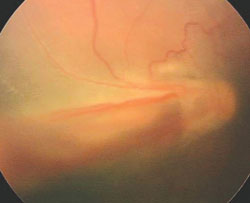Physicians urged to increase early screening for ROP
Retinopathy of prematurity is increasingly being recognized as an important cause of childhood blindness in India. It has been estimated that 0.2% of childhood blindness in India is because of ROP.
Rajvardhan Azad, MD, FRCS, said of the 26 million children born each year in India, 7.8 million are low birth weight infants — 1.68 million are less than 2,500 g and 0.36 million are less than 1,500 g — and they are at risk of developing ROP.
Screening for an emerging epidemic
 Rajvardhan Azad |
The emerging epidemic of ROP blindness in India is caused by a number of factors, such as the country’s high birth rate and high rate of preterm birth, Subhadra Jalali, MS, told Ocular Surgery News in an e-mail interview.
The incidence of ROP has also increased in recent years, Dr. Jalali said, because of the expanded provision for care and the improving survival rates for preterm infants. ROP occurs primarily because of premature delivery and is often aggravated because of fluctuating or unmonitored oxygen levels during the first few weeks of life. This is commonly seen at neonatal care centers that do not use pulse oximeter monitoring for all infants at all times or that set the pulse oximeter alarm to levels above 90% oxygen saturation. Administration of two doses of parenteral steroids to a mother in the second trimester of pregnancy provides some protection against severe ROP.
Unlike some Western countries, in India, even heavier infants and older gestational age infants develop ROP.
“The screening criteria adopted in the West are not adequate to cover all at-risk babies in India,” she said.
The cutoff point for ROP screening in the West is a birth weight of 1,500 g or less and gestational age of 32 weeks or less. However, there needs to be an extension of the guidelines to include all infants who are at risk of becoming blind due to ROP, Dr. Azad told OSN in an e-mail interview. In India, literature suggests a birth weight of 2,000 g or a gestational age of 34 or 35 weeks as the cutoff for ROP screening, irrespective of oxygen exposure.
 |
 |
|
Figures 1 and 2.
The progression of ROP from immature retina at birth (left) to stage 4B (right)
by 5 weeks after birth. Images: Jalali S |
|
Dr. Jalali said it is important not to miss infants whose gestational age is indeterminate irrespective of birth weight because birth weight can be abnormally and falsely high for infants with hydrocephalus, intestinal obstruction, renal problems or those born to mothers with diabetes. Screening must be completed by day 30 of life and can start as early as day 20 of life for very low birth weight infants who are less than 1,200 g at birth.
“ROP screening needs to become a routine practice just like immunization in children, and that goal is still very far away. To achieve this goal, a major education and awareness program among pediatricians, neonatologists, nurses, family physicians and public is needed,” she said.
Physicians’ care
Infants do not present with ROP at birth and are usually under the care of a physician for the first 2 to 4 weeks of life, so physicians must arrange screening for ROP during this time period, Dr. Jalali said.
“There is no reason why a baby should miss ROP screening if the medical doctor counsels the family and arranges for retinal examination at the correct time,” she said. “We do not need to go out in the community or perform door-to-door case finding, as patients are already in close contact with doctors and nurses who need to be made aware and educated about criteria and correct time for ROP screening.”
Dr. Jalali said the importance of ROP screening needs to be included in the curriculum of medical schools, so more physicians will personally push for screening programs at their centers. In cities where awareness is high and the program has been actively promoted, infants are referred on time, usually by 3 to 5 weeks of birth. However, where the level of awareness among pediatricians is low or where there is lack of leadership, infants are referred at an average of 7 months when a family member or friend notices that the child appears to not be seeing well.
“It is too late [then] except to refer the child to blindness rehabilitation centers in most cases. A foolproof surveillance net needs to be built around all [neonatal intensive care units, NICU] and preterm baby care providers, so that no preterm survivor escapes ROP screening,” she said.
The infant’s discharge summary also should indicate the need for immediate retinal examination if the infant was discharged before an eye examination was performed. Ideally, Dr. Jalali said, one dilated eye examination should be done before an infant is discharged from the hospital, and then proper counseling and follow-up information should be given to parents.
Currently, ROP is detected and managed in only a few centers in India, Dr. Azad said. Increasing manpower means additional training of the ophthalmologists in a highly specialized work. A quicker way to detect and refer treatable or at-risk infants is to train general ophthalmologists, pediatricians and neonatal nurses to screen the infants for ROP.
“Blindness can be prevented in nearly 100% [of the cases] if the infants are treated adequately at an appropriate time,” he said.
Leadership must improve awareness
Professional groups in major cities in India have taken a leadership role in improving awareness about ROP among the medical personnel and the general public, especially expectant mothers.
“The concerted efforts have set the ball rolling for capacity building and manpower training in ROP,” Dr. Jalali said.
More than 160 dedicated neonatologists and ophthalmologists have been trained to screen and detect ROP in several Indian towns and cities, Dr. Azad said. Four new centers have opened in New Delhi and 14 new ROP screening centers have opened across the country.
The efforts are supported by liberal grants from non-governmental organizations, such as Sightsavers International, Orbis International and Operation Eyesight Universal. Support also has been received from the World Health Organization and the International Agency for Prevention of Blindness, which included ROP as part of its “Vision 2020: The Right to Sight” global initiative.
The All India Ophthalmological Society formed a task force on ROP last year. Recently, Dr. Rachel Jose, a secretary with the Ministry of Health in India, coordinated an awareness campaign to tackle childhood blindness in India, including ROP. The World ROP Congress is scheduled for November in New Delhi.
Dr. Jalali said for the first time in India, a citywide, NICU-based, all-inclusive ROP screening program involving all major private and government hospitals has occurred in Hyderabad and Secunderabad. The active, ongoing surveillance, called Twin Cities ROP Study, was initiated in 1998 by a team from L.V. Prasad Eye Institute that visits all participating NICU once a week. Besides improving awareness, the team also provides ROP screening, laser treatment and follow-up care at pediatric clinics. Simultaneously, screening is available everyday during working hours at the L.V. Prasad Eye Institute premises.
Future efforts
Dr. Azad said ROP needs recognition, understanding and awareness among ophthalmologists, pediatricians, neonatologists, neonatal and ophthalmic nurses, and obstetricians to tackle this giant in the developing world. Recently, the L.V. Prasad Eye Institute started the first 1-month hands-on ROP fellowship program available anywhere in Asia. Divi Pharmaceuticals in Hyderabad provides funding for this training of six fellows annually.
Dr. Jalali said India needs a registry of ROP to know the true magnitude of the problem. The data available are a small proportion of the actual problem and confined to a few isolated center reports.
“Although the numbers are small, in terms of blind years, ROP is a huge challenge,” she said. “The opportunity to cost-effectively prevent this needless blindness is great and remains underutilized.”
Foremost on the agenda, however, is to establish national guidelines on ROP screening that needs to be endorsed by All India Ophthalmological Society and the Paediatric and Neonatology Societies of India, Dr. Jalali said. — by Kristine Houck
References:
- Azad R. Retinopathy of prematurity – a giant in the developing world. Indian Pediatr. 2009;46(3):211-212.
- Jalali S, Anand R, Kumar H, Dogra MR, Azad R, Gopal L. Programme planning and screening strategy in retinopathy of prematurity. Indian J Ophthalmol. 2003; 51(1):89-99.
- Rajvardhan Azad, MD, FRCS, can be reached at the Dr. Rajendra Prasad Centre for Ophthalmic Sciences, All India Institute of Medical Sciences, Ansari Nagar, New Delhi-110029; +11-26593187; fax: +11-26588919; e-mail: rajvardhanazad@hotmail.com.
- Subhadra Jalali, MS, can be reached at L.V. Prasad Eye Institute, Kallam Anji Reddy Campus, L.V. Prasad Marg, Banjara Hills, Hyderabad - 500 034 Andhra Pradesh, India; +91-40-30612607; fax: +91-40-23548271; Web site: www.lvpei.org; e-mail: subhadra@lvpei.org.

